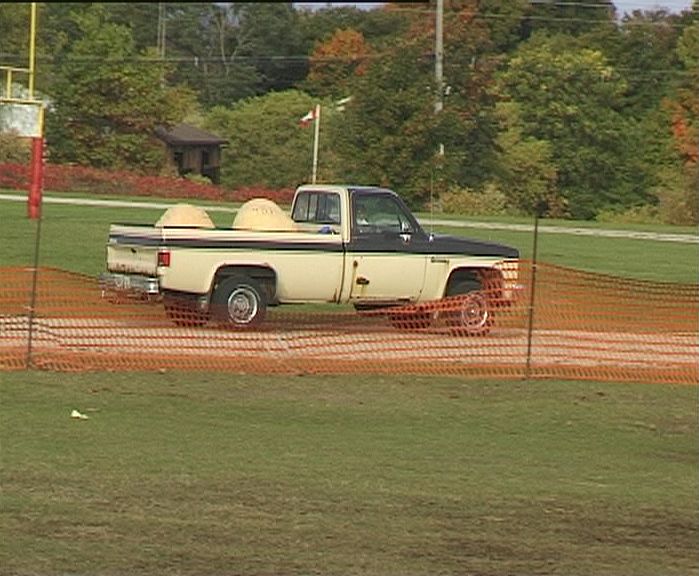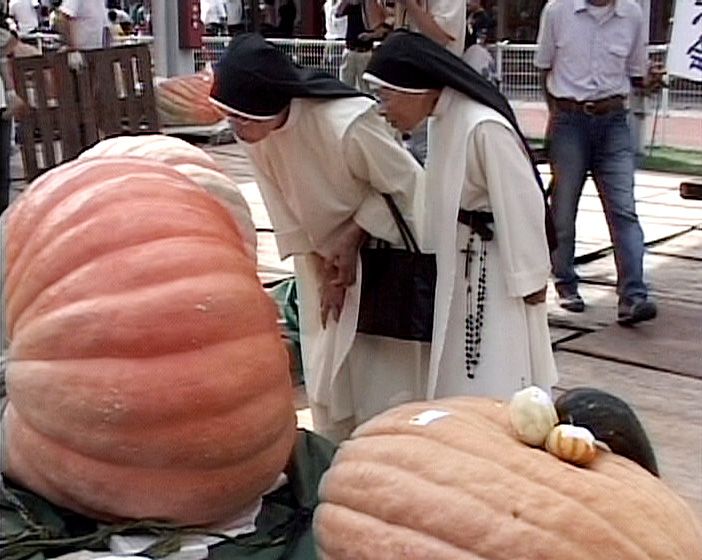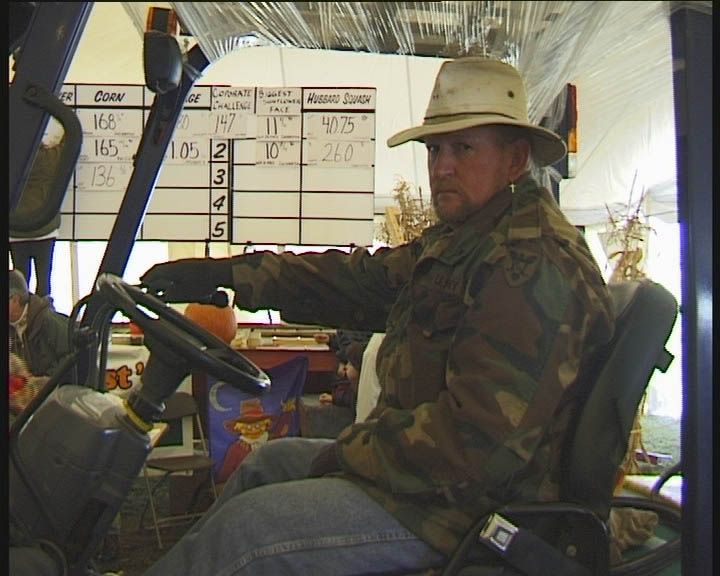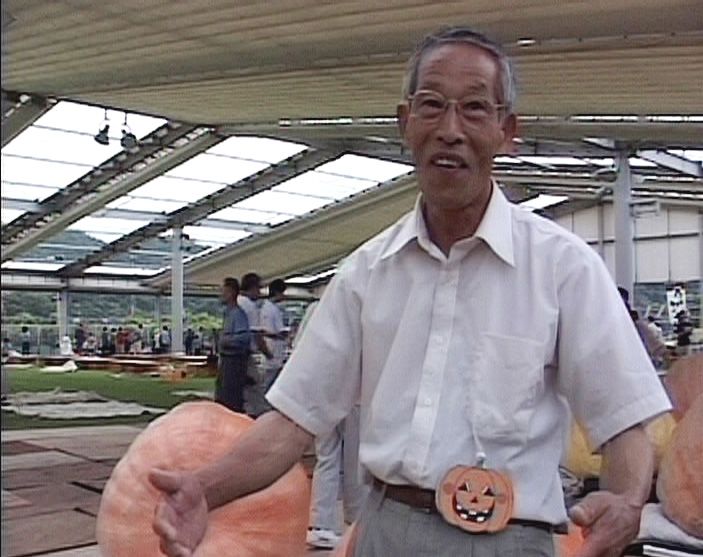01.03.03—26.04.03
Location:
, ARGOS vzw
, ARGOS vzw
Gert Verhoeven - The Blob / Bustutai
exhibition

Copyright artist(s) and courtesy argos
Gert Verhoeven works with drawings, sculptures and videos. Rather than the results of a creative process they are his working tools. It is not as much the invention of forms or a style that matters to him but the exploration of the possibilities of the visual arts, determining the place(s) of art within the complex of social practices.
Gert Verhoeven works with drawings, sculptures and videos. Rather than the results of a creative process they are his working tools. It is not as much the invention of forms or a style that matters to him but the exploration of the possibilities of the visual arts, determining the place(s) of art within the complex of social practices.
In 2001 Gert Verhoeven presented a first draught of The Blob (2001) on a wide screen at the Palace for Fine Arts. This video is a report on the "World Pumpkin Confederation Contest" in Buffalo, New York and Port Elgin, Ontario, Canada. The recording style is typical of a straight documentary but also extremely fragmentary, leaving the spectator without a clue on what it is about at first. Jerkily he keeps seeing the image of pumpkins, giant pumpkins. In all their squatness and flabbiness they are subject to a multitude of curious manipulations by masculine hands and fork trucks.
Due to the lack of a storyline the attention of the spectator clings itself to formal details and actions: the various (un)shape(lines)and the colours of the pumpkins, the ingenious knot work of ropes and leather belts nipped in which they move about the screen, the endearing variety of pallets, mattresses, carpets and blankets on which they are displayed,... The comments and dubious questions of the voice-over in the distant background mainly serve as white noise. Yet, after some guesswork the viewer can make out he is watching a persiflage in which the pumpkins are put forward as artworks-in-progress, whereas the absurd ritual of the contest is a reference to the machinations of the accompanying art market. Oddly enough text and images are so far apart that the pumpkins remain essentially ponderous, plump objects. Almost comically they refuse to act as metaphors for sculptures, ideas or other manageable concepts.
Bustutai (2003) is a sequel to The Blob and it tells exactly the same story, in the same contrary tone, with this difference that the images were recorded in Japan, during the "Giant Pumpkin Contest" on Shodoshima Island in the Kagawa prefecture. In the era post Documenta XI Bustutai becomes The Blob raised to the square, as the work is additionally being plugged into the process of globalisation and postcolonial thinking. In his very own way Gert Verhoeven raises the question how real a genuine Japanese pumpkin contest can be. Is this merely a typically Japanese, naïve simulation; does the model shift out of balance, does everything stay as it was or is there a road opened to transformation and new impulses? What happens, for instance, when the "Kotobuki Choir" is brought in, singing a cappella "to lighten the air of intense competition as local farmers vie for the title"?
Gert Verhoeven works with drawings, sculptures and videos. Rather than the results of a creative process they are his working tools. It is not as much the invention of forms or a style that matters to him but the exploration of the possibilities of the visual arts, determining the place(s) of art within the complex of social practices.
At argos the videos are shown in alteration on opposing projection screens. In a second environment Gert Verhoeven made a collage of the scenarios preceding the videos.
Gert Verhoeven works with drawings, sculptures and videos. Rather than the results of a creative process they are his working tools. It is not as much the invention of forms or a style that matters to him but the exploration of the possibilities of the visual arts, determining the place(s) of art within the complex of social practices.
In 2001 Gert Verhoeven presented a first draught of The Blob (2001) on a wide screen at the Palace for Fine Arts. This video is a report on the "World Pumpkin Confederation Contest" in Buffalo, New York and Port Elgin, Ontario, Canada. The recording style is typical of a straight documentary but also extremely fragmentary, leaving the spectator without a clue on what it is about at first. Jerkily he keeps seeing the image of pumpkins, giant pumpkins. In all their squatness and flabbiness they are subject to a multitude of curious manipulations by masculine hands and fork trucks.
Due to the lack of a storyline the attention of the spectator clings itself to formal details and actions: the various (un)shape(lines)and the colours of the pumpkins, the ingenious knot work of ropes and leather belts nipped in which they move about the screen, the endearing variety of pallets, mattresses, carpets and blankets on which they are displayed,... The comments and dubious questions of the voice-over in the distant background mainly serve as white noise. Yet, after some guesswork the viewer can make out he is watching a persiflage in which the pumpkins are put forward as artworks-in-progress, whereas the absurd ritual of the contest is a reference to the machinations of the accompanying art market. Oddly enough text and images are so far apart that the pumpkins remain essentially ponderous, plump objects. Almost comically they refuse to act as metaphors for sculptures, ideas or other manageable concepts.
Bustutai (2003) is a sequel to The Blob and it tells exactly the same story, in the same contrary tone, with this difference that the images were recorded in Japan, during the "Giant Pumpkin Contest" on Shodoshima Island in the Kagawa prefecture. In the era post Documenta XI Bustutai becomes The Blob raised to the square, as the work is additionally being plugged into the process of globalisation and postcolonial thinking. In his very own way Gert Verhoeven raises the question how real a genuine Japanese pumpkin contest can be. Is this merely a typically Japanese, naïve simulation; does the model shift out of balance, does everything stay as it was or is there a road opened to transformation and new impulses? What happens, for instance, when the "Kotobuki Choir" is brought in, singing a cappella "to lighten the air of intense competition as local farmers vie for the title"?
Gert Verhoeven works with drawings, sculptures and videos. Rather than the results of a creative process they are his working tools. It is not as much the invention of forms or a style that matters to him but the exploration of the possibilities of the visual arts, determining the place(s) of art within the complex of social practices.
At argos the videos are shown in alteration on opposing projection screens. In a second environment Gert Verhoeven made a collage of the scenarios preceding the videos.
Location:
argos
Opening hours:
Tuesday to Saturday, 12:00 to 19:00
Entrance fee:
free
argos
Opening hours:
Tuesday to Saturday, 12:00 to 19:00
Entrance fee:
free



